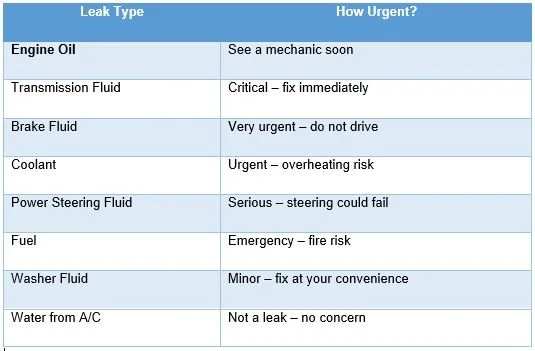Car Leaking? Here’s How to Decode the Fluid
You walk out to your car and spot a puddle underneath. Your first thought might be “how bad is this?” Don’t worry just yet. Most car leaks leave clues that can help you figure out what’s going wrong and how serious it really is.
This post will help you identify the fluid leaking from your car, understand where it might be coming from, and know what to do next. Acting quickly can help you avoid expensive repairs or dangerous situations.
Step One: Observe the Leak
Before jumping to conclusions, spend a few moments observing. The color, smell, and location of the fluid can tell you a lot.
Check Where the Fluid Is Dripping
Look at the location under your car. Is the leak toward the front, middle, or rear? This will help narrow down the possible sources.Look at the Color and Feel
Is the fluid clear, oily, thick, sticky, or watery? Color and texture are major indicators of what you’re dealing with.Smell It (Carefully)
Fluids have distinct smells. Some are sweet, some are sharp, and some are just plain gross. This is another useful clue.Estimate How Much Is Leaking
A couple of drops might not be a big deal, but a large puddle means something is wrong and getting worse.
Common Car Fluids and How to Identify Them
Let’s look at the most common types of fluids that leak from vehicles and how you can identify them.
1. Engine Oil
Color: Light brown when new, dark brown or black when old
Feel: Slick and greasy
Smell: Slightly burnt or mechanical
Location: Usually leaks from the front or middle of the engine
Common sources: Oil pan, valve cover gasket, oil filter, drain plug
How serious?
Moderately to very serious. Oil is essential to keeping your engine lubricated. If your oil level gets too low, it can cause permanent damage.
2. Transmission Fluid
Color: Bright red when new, brown or dark red when old
Feel: Slick and oily
Smell: Sweet or burnt
Location: Often toward the center of the vehicle
Common sources: Transmission pan gasket, cooler lines, front or rear seals
How serious?
Very serious. Without enough transmission fluid, your car may stop shifting properly or suffer internal damage. This is one of the more expensive leaks to ignore.
3. Coolant (Antifreeze)
Color: Usually green, orange, pink, or yellow
Feel: Slimy or slightly sticky
Smell: Very sweet, almost like syrup
Location: Near the front of the engine or radiator
Common sources: Radiator, hoses, water pump, heater core
How serious?
Serious. Coolant regulates your engine’s temperature. A leak can cause overheating, especially on hot days or during long drives.
Note: Never open the radiator cap while the engine is hot. You could be burned by escaping steam or fluid.
4. Power Steering Fluid
Color: Reddish, amber, or light brown
Feel: Oily and slippery
Smell: Burnt or sharp mechanical odor
Location: Near the front of the vehicle
Common sources: Steering rack, power steering pump, hoses
How serious?
Quite serious. A sudden drop in fluid can make the steering wheel difficult to turn and affect your ability to control the car.
5. Brake Fluid
Color: Clear to yellow when new, dark brown when old
Feel: Very slippery, similar to cooking oil
Smell: Slightly chemical
Location: Near the wheels or under the brake master cylinder
Common sources: Brake lines, calipers, master cylinder
How serious?
Extremely serious. A brake fluid leak could lead to brake failure. If you suspect this type of leak, do not drive the vehicle. Have it towed to a shop for immediate inspection.
6. Gasoline
Color: Clear or slightly yellow
Feel: Thin and quick to evaporate
Smell: Very strong and obvious
Location: Under the gas tank, near the fuel lines, or under the engine
Common sources: Fuel lines, fuel injectors, fuel tank
How serious?
Extremely serious. A fuel leak is both a fire risk and a legal issue. Stop driving the car and get it towed.
7. Windshield Washer Fluid
Color: Bright blue, green, or sometimes orange
Feel: Watery and slightly slick
Smell: Mild or alcoholic
Location: Near the front of the car
Common sources: Reservoir, pump, or hoses
How serious?
Not very. This is a convenience issue, not a safety concern. You can fix it when you have time.
8. Water from the Air Conditioner
Color: Clear
Feel: Just like water
Smell: None
Location: Front passenger side
Common sources: Condensation drain
How serious?
Not a problem at all. This is normal when your air conditioning is working properly and the evaporator drain hose is not clogged, especially on humid days.
Most Common Leak Locations
Here are the most likely spots where a leak might originate:
Under the engine: This is the most common place for oil, coolant, and power steering fluid leaks
Middle of the car: Often a sign of transmission fluid leaking
Near the wheels: Could be brake fluid or gear oil from the axles
Rear of the car: Possibly fuel-related or from a rear differential
Around hoses and clamps: Coolant and washer fluid leaks often occur where hoses attach
How Urgent Is Your Leak?
How to Perform a Simple Leak Test at Home
You can do a basic test to monitor leaks without any tools.
Slide a piece of cardboard or old sheet under the vehicle overnight
This helps catch and isolate the drips.Use a marker to circle new drips
The location on the cardboard can help match the fluid to its source.Compare fluid appearance with the guide above
This gives you a good idea of what’s leaking and whether it’s serious.
Can You Still Drive With a Leak?
It depends on what’s leaking. Here’s a quick guideline:
Engine oil leaks: You can drive short distances if the oil level is okay, but get it fixed soon.
Transmission fluid leaks: Not safe to drive if fluid is low or shifting feels rough.
Brake fluid leaks: Do not drive. Get towed.
Coolant leaks: You might be able to drive short distances, but monitor the temperature gauge closely.
Fuel leaks: Never safe. Park the car and get professional help.
Washer fluid leaks: Safe to drive, just refill as needed.
Water drips: Normal. Keep driving.
How Much Do Common Leak Repairs Cost?
I was going to post an estimate chart here, but causes and repairs vary widely depending on the complexity of the engine and the cost of your manufacturer’s parts. Some cars are basic to work on. Other cars take more time when they have problems.
One of the most expensive and problematic leaks to see is actually a mix of engine oil and coolant because this leak can indicate systems that shouldn’t mix internally are mixing.
Tips to Prevent Leaks in the Future
Keep up with scheduled maintenance.
Change fluids and check systems regularly.Inspect your driveway or parking spot regularly.
Catching drips early gives you a head start.Listen for strange sounds or smells.
Hissing, burning, or squealing noises may indicate leaks.Use quality fluids and parts
Cheap parts can fail faster and cause more leaks.Have a trusted mechanic inspect your car annually
Preventative checks can save you from unexpected expenses.
Final Thoughts
Finding a leak under your car is not fun, but it is not the end of the world. Understanding what’s leaking and how to respond puts you back in control. Whether it’s a harmless drip of washer fluid or a dangerous brake fluid leak, you now have the knowledge to take the right next step.
If you catch a leak early and handle it quickly, you can often avoid major damage or high repair costs. Pay attention to what your car is telling you. Small signs can mean big savings.
If you need to chat about your specific situation, book with us. For more car care tips, follow us at @askamechaniccarkids.



